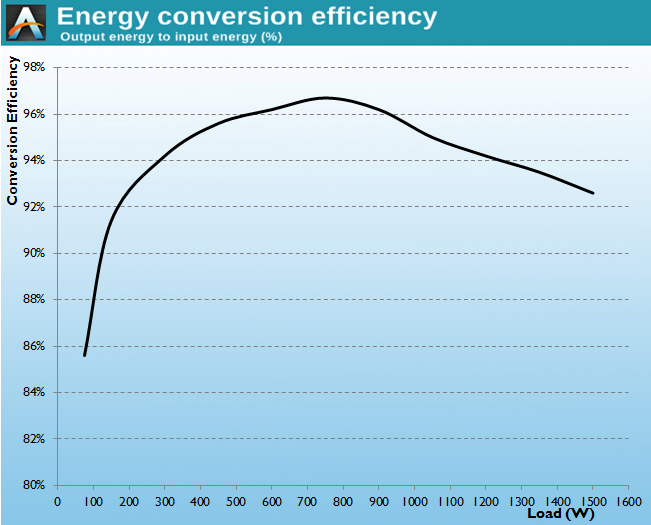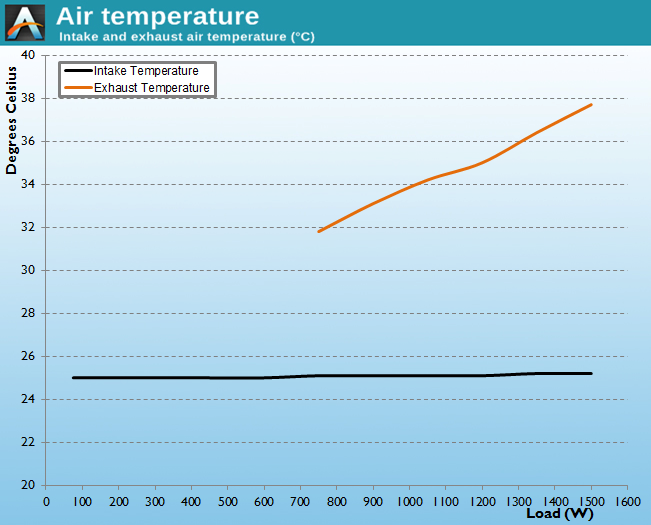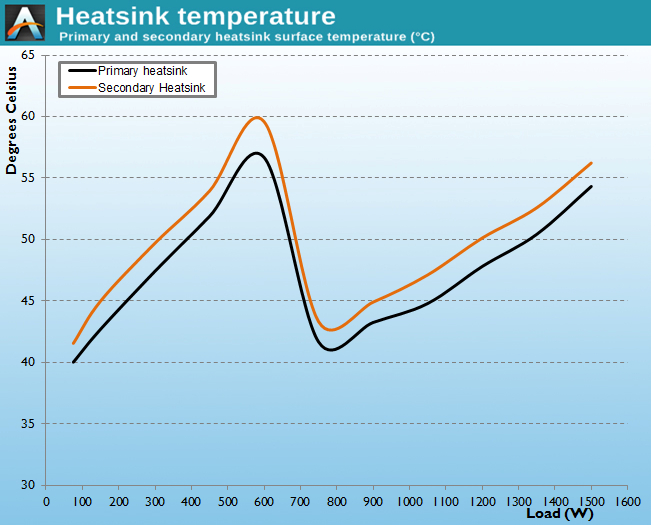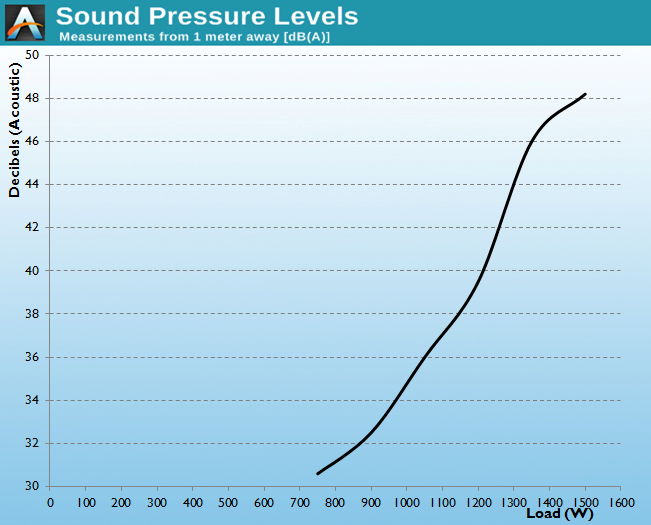Corsair AX1500i Power Supply Review
by E. Fylladitakis on September 11, 2014 5:00 AM EST- Posted in
- Cases/Cooling/PSUs
- Corsair
- PSUs
- 1500W
Cold Test Results
For the testing of PSUs, we use high precision electronic loads with a maximum power draw of 2700 Watts, a Rigol DS5042M 40MHz oscilloscope, an Extech 380803 power analyzer, two high precision UNI-T UT-325 digital thermometers, an Extech HD600 SPL meter, a self-designed hotbox, and various other bits and parts. For a thorough explanation of our testing methodology and more details on our equipment, please refer to our How We Test PSUs – 2014 Pipeline post.
The Corsair AX1500i delivered record-breaking performance at room temperature, with an impressive average conversion efficiency within the nominal load range (20% to 100%) of 94.9%. The maximum conversion efficiency is exactly 96.7% at 50% load, which is more than adequate for an 80 Plus Titanium certification under 230VAC input.
For 110VAC grids, the 80 Plus Titanium certification is more lenient, dictating an efficiency of at least 94% and thus the AX1500i should easily surpass it. Perhaps the most important point that we can make regarding the efficiency of the AX1500i is the low-load efficiency, which is at 85.6% at just 5% load, an astonishing figure considering that there are hardly any computer PSUs that will surpass 78% efficiency at 5% load. Of course, 5% load in this case is still 75W, and there are many PCs that idle at levels far below that value.
The cooling system of the Corsair AX1500i is based on "smart" thermal management, with the fan not turning on at all before it is necessary. Considering its output, the AX1500i is an astoundingly cool running unit, allowing it to operate without the help of the fan under loads that surpass the entire output of typical consumer/gaming PSUs. When the fan does start however, it does not remain quiet for long, with its speed increasing alongside the load. In the unlikely event that the AX1500i remains loaded at 80% capacity (or more) for several minutes, the fan is clearly audible from many meters away.















55 Comments
View All Comments
CrazyElf - Thursday, September 11, 2014 - link
It will mostly be of use for people who are using quadruple GPU configurations or highly overclocked triple GPU configurations.But yes, as the article notes, it's a niche product and arguably an overpriced product for what it offers. We'll see what similar 1500-1600W PSUs offer by other manufacturers in the coming months.
Vatharian - Thursday, September 11, 2014 - link
Good, you mentioned, almost. I've build recently dual cpu (using Supermicro X9DRG-QF), 5 GPU (Titan black) workstation, water cooled (for sake of efficiency and longevity, not wow factor), and it refused to boot on Corsair AX1200i, switched to dual Seasonic X1250, and it peaks around 2.1kW from wall (on 230V).piroroadkill - Thursday, September 11, 2014 - link
Holy shit. Now that's baller.mapesdhs - Thursday, September 11, 2014 - link
And I thought my quad-580 3930K was nuts. :DCool dude!!
Ian.
Chrispy_ - Monday, September 15, 2014 - link
Assuming you're running an SSI EEB board, you should really be using server-grade EPS supplies rather than this consumer junk. Drawing 2.1kW from the wall is all the evidence you should need for this! ;)Barilla - Thursday, September 11, 2014 - link
80+ and 80+ titanium are two different things. And there are actually some people that need this kind of power, although not many.Sabresiberian - Thursday, September 11, 2014 - link
You know what is really useless? Comments about how a product is useless.They do more to show how limited the imaginations of the authors (of such comments) are than anything else.
petteyg359 - Sunday, February 15, 2015 - link
Just because you don't give a crap about efficiency doesn't mean others won't. Going from 84% to 92% efficiency on a 500W load is over 1.2 kWh saved every day. At $0.15 per KWh, the PSU will more than pay for itself within the warranty period.Pissedoffyouth - Thursday, September 11, 2014 - link
As a 220v user (New Zealand), due to higher efficiency should we also see lower temperatures?DanNeely - Thursday, September 11, 2014 - link
Slightly. 220v is generally 1-2% more efficient than 110; meaning at full load you'd have 15-30W lower losses being converted into heat.